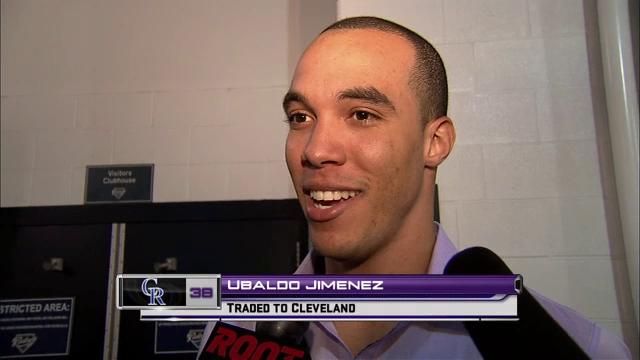 There are times in life where you remember exactly where you were the moment something happened. More often than not, that “something” is a big event. For me, July 30, 2011 wasn’t exactly a big event, but rather a day that I will remember because it was my first experience seeing a trade go down right before my eyes. It was one of the biggest trades in recent Indians history and a lot has happened in the two years since.
There are times in life where you remember exactly where you were the moment something happened. More often than not, that “something” is a big event. For me, July 30, 2011 wasn’t exactly a big event, but rather a day that I will remember because it was my first experience seeing a trade go down right before my eyes. It was one of the biggest trades in recent Indians history and a lot has happened in the two years since.
The scene was
Pomeranz began to go through his pre-start routine, stretching, jogging, and playing some long toss with his catcher. After a brief chat with one of the coaches, Pomeranz ended his pre-start preparation and strolled back to the dugout. A different Akron Aeros player began warming up and it appeared that Pomeranz had been traded. He hugged several teammates in the dugout and sat on the top bench near the end of the dugout, looking rather uncomfortable. The best way to sum it up was that Pomeranz looked “fidgety”.
Working with my first smartphone, I began trying my best to find any information I could on the potential trade. Initially, Pomeranz was just scratched in the event of a possible trade. Shortly thereafter, it had been confirmed that Pomeranz would be the player to be named later in the Ubaldo Jimenez trade with the Colorado Rockies. I don’t remember the rest of the Aeros game. I heard the end of the Indians game on the drive home. Matt LaPorta hit a walk-off three-run homer off of Joakim Soria to push the Indians’ record to 53-51, as they desperately tried to hang on in the AL Central.
Jimenez would inexplicably make his scheduled start for the
The trade would probably be described as a win for the Indians, mostly because Pomeranz and White have not amounted to anything at the Major League level. Jimenez’s wins above replacement player for the Indians sits at exactly zero, making him a very replaceable commodity. In his 63 starts for the Indians, Jimenez is 21-26 with a 4.95 ERA. In 30 starts with the
Jimenez clearly hasn’t panned out the way the Indians hoped he would. His velocity continued to drop and his margin for error went down along with it, as he has allowed 47 home runs in 354.1 innings, after allowing just 55 in 851 innings in hitter-friendly Coors Field. His strikeout rate dropped and his walk rate spiked. He’s been serviceable at best, while averaging less than six innings per start.
On the surface, the Jimenez trade looks like a win simply because he is actually contributing at the Major League level while Pomeranz and White have been awful and haven’t been able to consistently stay in the big leagues. Where the trade unequivocally failed is that the Indians used two good trade chips to acquire a player whose red flags have come to fruition. The velocity drop was evident in 2011. Jimenez had lost nearly three miles per hour in average fastball velocity from 2010 to 2011. In 2010, it was at 96.1 mph. In 2013, Jimenez’s average fastball sits at 91.4 mph. Not that velocity is everything, but a guy with poor command and control will have a very hard time sitting in the low-90s.
Of late, Jimenez has pitched well in the traditional stats, posting a 7-3 record with a 3.36 ERA since the start of May. In those 88.1 innings, however, Jimenez has allowed 129 baserunners and 11 home runs. Advanced metrics call for significant regression, with a much higher FIP and a very high left on base rate for a pitcher of Jimenez’s caliber. The Indians will no doubt enjoy it while it lasts and the job that Mickey Callaway, Kevin Cash, and Terry Francona have done with Jimenez is impressive. They got through to Jimenez, convincing him that he has to become a pitcher, not just a thrower. He can’t rely on upper-90s stuff anymore to get hitters out. By percentage, Jimenez is throwing the fewest fastballs of his career and the highest number of sliders and changeups this season.
Two years after the trade, we look back and call it a win for the Indians, but only by default. The idea of acquiring a cost-controlled starting pitcher with a team-friendly contract was admirable, and Jimenez’s performance in 2013 has kept the trade from being a major failure. Instead, it’s a minor failure, for failing to truly maximize the assets the Indians gave up.
As I said back on July 31, 2011 about the Jimenez trade, “It is the kind of risk you absolutely have to take in this market. You cannot sit idly by and hope that your prospects come through when you get the chance to get a proven pitcher.” Unfortunately, Jimenez wasn’t nearly as proven as we thought, though the prospects didn’t come through. Knowing what we know now, would you still make the deal again?
It’s two years later and the Indians are in contention with Jimenez playing a big role. It’s certainly not the way Antonetti and his staff envisioned it, but all things considered, it’s not the worst trade in Indians history.